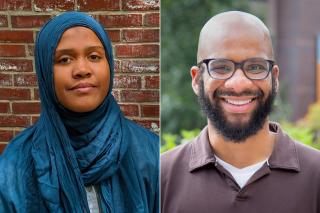In early November, writer, educator, and Children's Literature specialist Autumn Allen '18MA/MFA and Associate Professor of Education and Social Work Dr. Daren Graves offered a Zoom presentation to the Simmons community, "Talking with Children about Race and Racism: Using Children's Books and Other Effective Tools." A direct response to community requests, the presentation was sponsored by Simmons University's Office of Organizational Culture, Inclusion and Equity and the University's President's Advisory Council on Diversity, Equity, and Inclusion. Curriculum and Research Librarian & Team Lead Stacy Collins '16MA/MS facilitated the discussion.
First, some may ask, why talk to children about race and racism?
"Kids learn through media, school, and their peers," said Graves, noting that kids pick up on messages both implicit and explicit. As adults, it's our role to question how and what they are learning. "Adults can help young kids make sense of these issues and feel empowered to do something about it."
Race, as Graves described, is more than skin color — it's a combination of beliefs and material privileges, or lack thereof, afforded to a group of people. While not biological, race is something we make real with our beliefs. "The idea of race confers privileges," said Graves. Further, racism is a system that helps perpetuate the ideas and behaviors that confer privileges and disparate outcomes on the basis of race.
Critical media literacy is important, Graves noted, as it offers "ways to consume texts and media that help us understand how power and privilege work." Not only are kids consuming media and learning from their peers, they are also modeling our behavior.
"A stereotype is when one story is told about a group of people," said Allen, noting that this 'single story,' a phrase coined by novelist Chimamanda Ngozi Adichie, doesn't account for full diversity or intersectionality within groups. Picking up the thread of critical media literacy, Allen offered advice for selecting books for children. "Pay attention to the power dynamics on the page," she said. "Who is the powerful, active child?" She noted that her own children enjoy reading books that feature children of color in a contemporary setting, living "normal" lives and having fun. To avoid the limiting "one story," characters of color shouldn't be relegated only to stories of struggle.
Books can be used to start conversations about differences among humans, starting with skin color. Book discussions with young people can lead naturally to complex systemic issues, such as mistrust of medical professionals within some Black communities, the intergenerational wealth withheld from Black communities through decades of redlining, and gentrification that continues to threaten BIPOC communities. Allen asked role models to be aware of their own biases and privileges when assessing their willingness to broach these subjects.
"Model lifelong learning," said Allen, "say 'I don't know' and show kids that we are all still learning. Everyone can look things up."
All media can, even unintentionally, reproduce racism by offering problematic representations. When you consider media (books, TV, movies, podcasts) for your child, consider who is telling the story, and who is the intended audience. Allen advised the audience to question their defensive feelings about certain "classics" of children's literature with problematic elements. "Nostalgia is not the best guide to books," she said. If these books, which are predominantly focused on the white perspective, are read in school, pair them with contemporary books that counter those limited points of view.
In addition, learn from your children about the media they like to consume. "Act as a curious observer as opposed to gatekeeper," said Graves, who asks his children about their media preferences. "See children as experts to learn from."
For Autumn Allen's book recommendations, visit her website.

